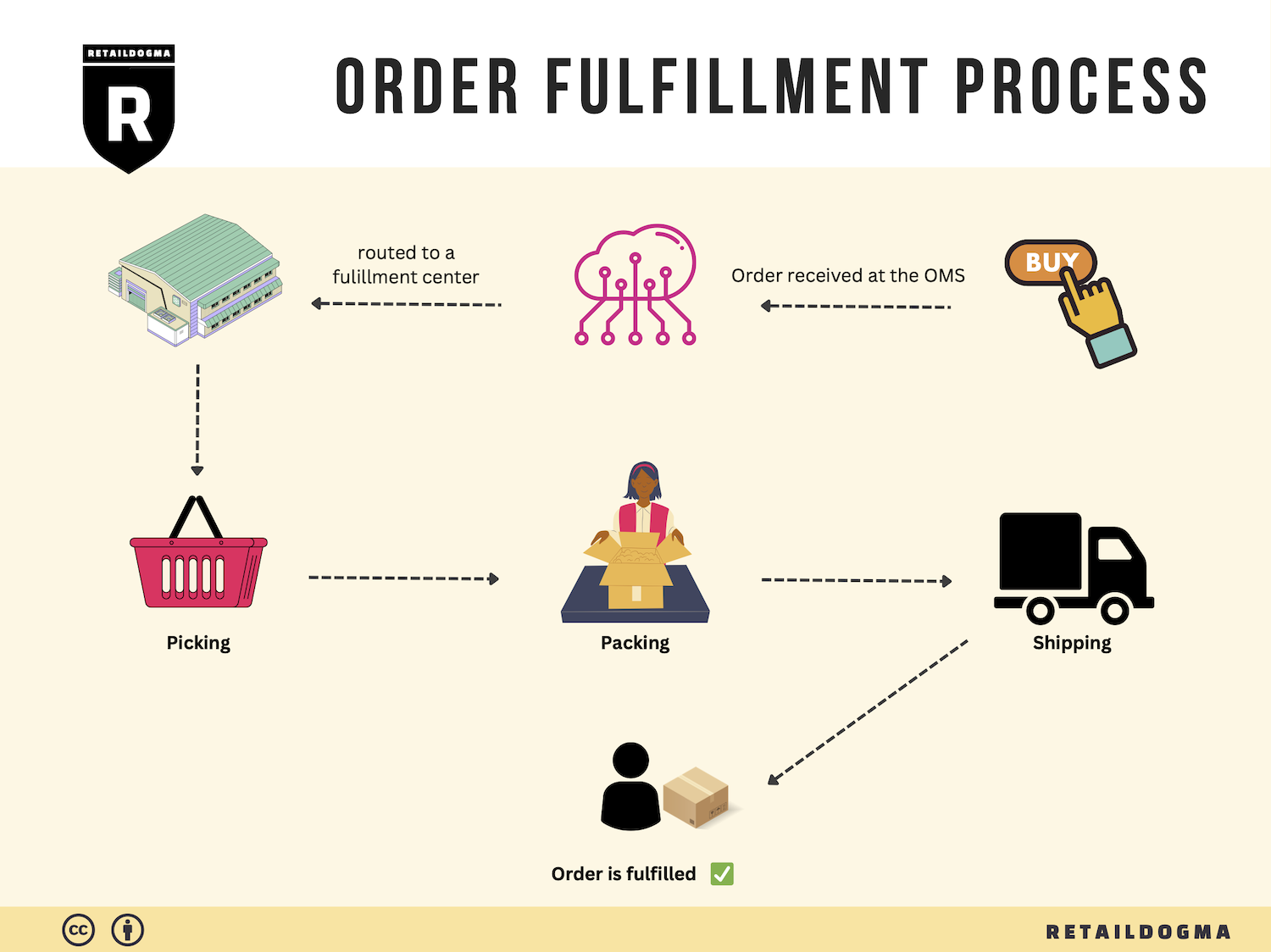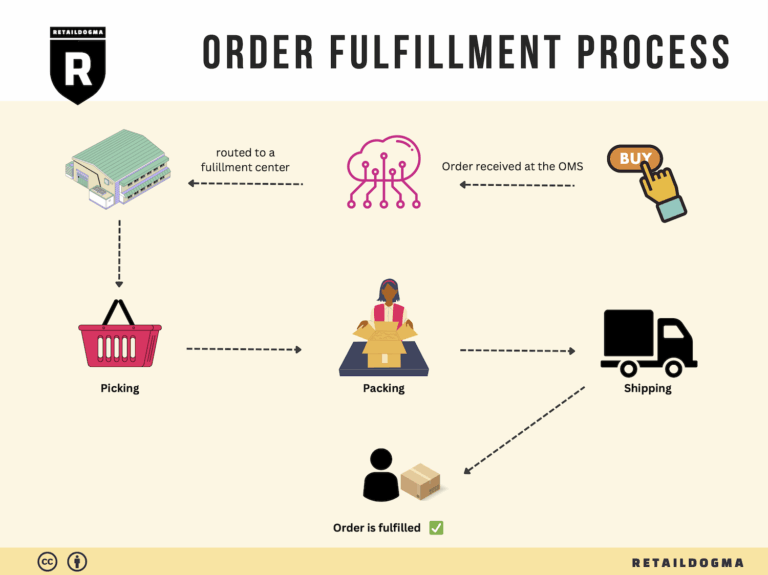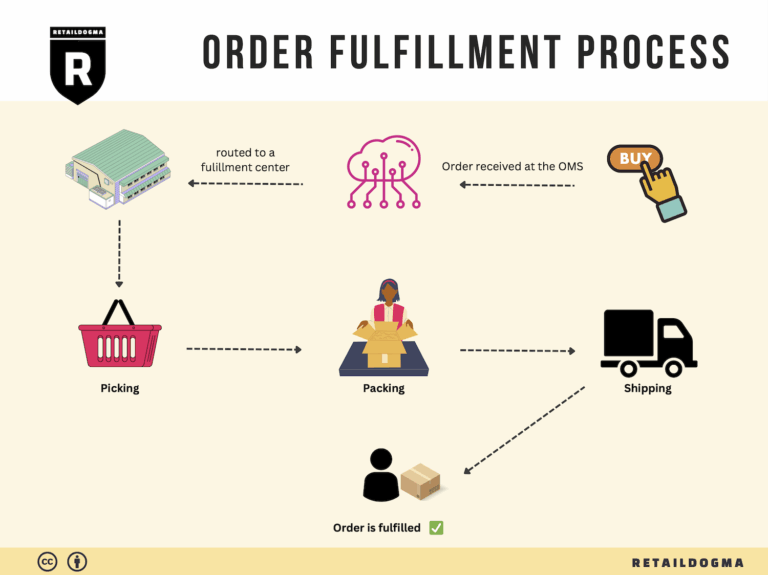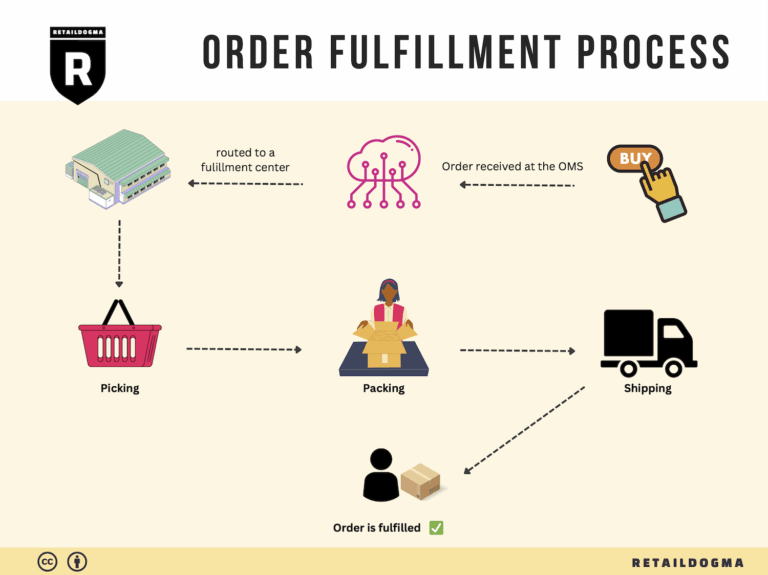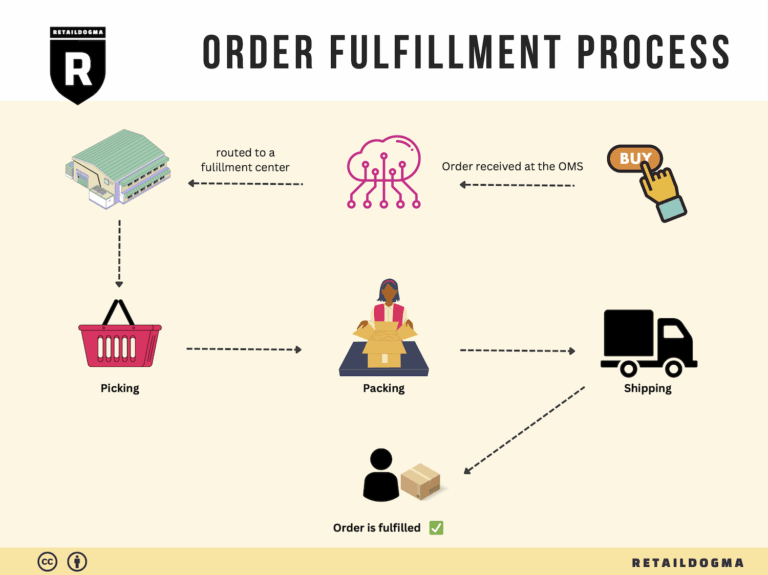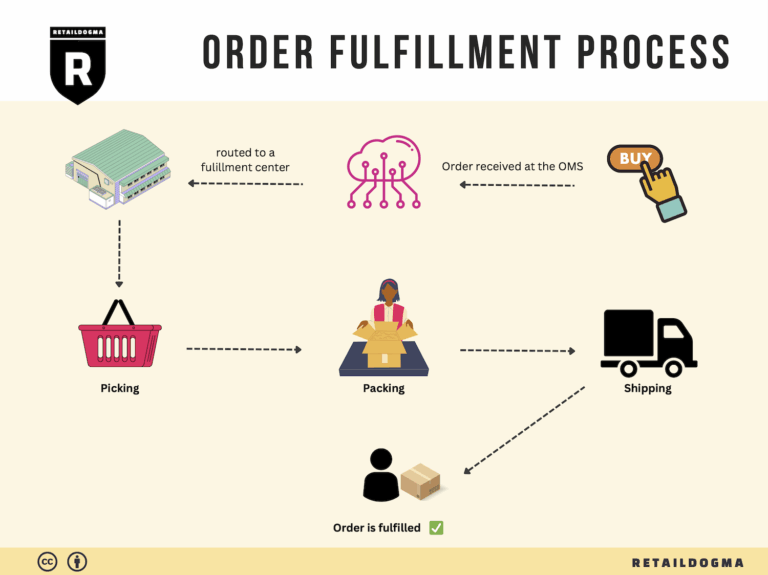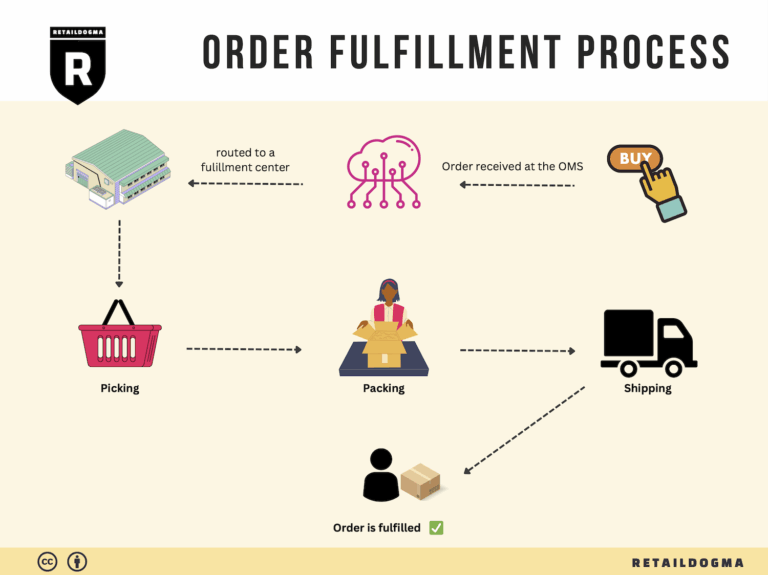How Order Fulfillment Works: A Step-by-Step Guide for Businesses
What is E-commerce Fulfillment? An Introduction for Growing Businesses
Understanding E-commerce Fulfillment
As your e-commerce business begins to grow, you may find yourself grappling with the increasingly complex task of packing and shipping orders. The excitement of rising sales can quickly turn into a logistical nightmare, leaving you overwhelmed and struggling to keep up with customer expectations. This is where e-commerce fulfillment comes into play—a crucial process that ensures your products reach your customers efficiently and accurately.
At its core, fulfillment is the systematic process of getting a product from your warehouse to the hands of the customer. It encompasses everything from inventory management and order picking to packing, shipping, and handling returns. For many online businesses, partnering with a third-party logistics provider (3PL) or utilizing Fulfillment by Amazon (FBA) can streamline these operations, allowing you to focus on growing your brand rather than getting bogged down in logistics.
This guide will explore the various fulfillment models available to growing businesses. We will delve into the pros and cons of using a 3PL versus FBA, helping you understand which model aligns best with your business needs. Additionally, we will outline the core services offered in the fulfillment process, such as kitting, assembly, and returns management, ensuring you have a comprehensive understanding of what to expect from your fulfillment partner.
Choosing the right fulfillment partner is a pivotal decision that can significantly impact your business’s efficiency and customer satisfaction. This guide will provide practical tips on how to evaluate potential partners, including key questions to ask and factors to consider. We will also cover pricing structures, giving you insights into what to look for in terms of cost-effectiveness and service value.
Ultimately, our goal is to empower you with the knowledge and tools necessary to make informed decisions about your logistics strategy. By understanding the ins and outs of e-commerce fulfillment, you can optimize your operations, enhance customer satisfaction, and drive your business growth. Whether you’re a seasoned entrepreneur or just starting, this guide will serve as your roadmap to mastering the logistics of e-commerce fulfillment.
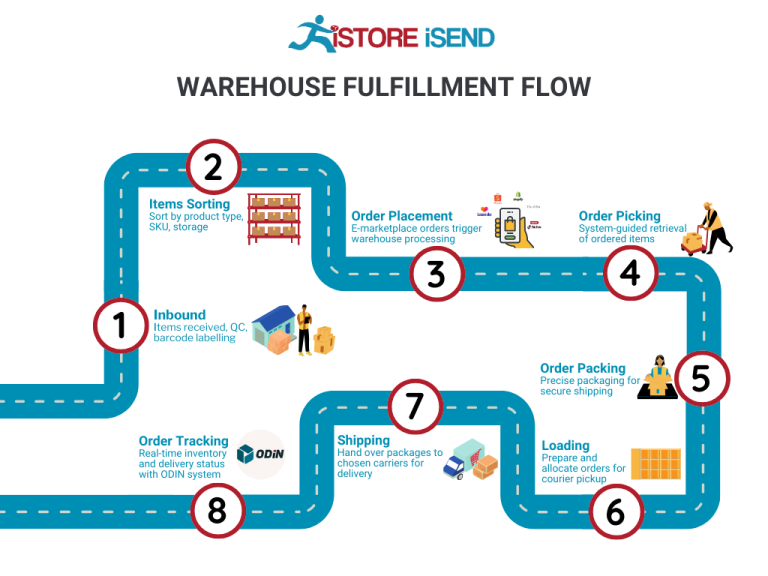
What You’ll Learn In This Guide
- What is E-commerce Fulfillment? An Introduction for Growing Businesses
- The Order Fulfillment Process: From ‘Buy’ Button to Customer’s Door
- Comparing Fulfillment Models: In-House vs. 3PL vs. Dropshipping
- A Deep Dive into Amazon FBA: Pros, Cons, and Who It’s For
- Core Services Offered by Fulfillment Centers
- How to Choose a Fulfillment Partner: A 6-Point Checklist
- Understanding Fulfillment Pricing: A Breakdown of Common Fees
- Frequently Asked Questions (FAQs) about Fulfillment
- Conclusion: Is Outsourcing Fulfillment the Right Move for Your Business?
- Important Disclaimer
The Order Fulfillment Process: From ‘Buy’ Button to Customer’s Door
1. Receiving Inventory
The first step in the order fulfillment process begins when products arrive at the warehouse. This stage, known as receiving inventory, involves inspecting and logging incoming goods to ensure they match the purchase order specifications. Each product is assigned a unique SKU (Stock Keeping Unit), which allows for easy tracking and management of inventory.
This step is crucial as it sets the foundation for efficient inventory management. If products are received incorrectly—whether through damage, miscounts, or incorrect items—this can lead to stockouts, delays, and customer dissatisfaction later in the process. A well-organized receiving area with clear protocols helps streamline this step. Implementing a robust Warehouse Management System (WMS) can facilitate real-time tracking of inventory levels, ensuring accurate data is available for forecasting and order fulfillment.
2. Warehouse Storage
Once inventory is received, it is stored in designated areas within the warehouse. Warehouse storage involves strategically placing products to optimize space and enhance accessibility for future order fulfillment. Effective storage solutions often utilize bin locations and shelving systems that categorize products based on size, weight, or frequency of sale.
This step is important because efficient storage reduces the time it takes to locate items during the picking process, directly impacting overall fulfillment speed. Additionally, a well-organized warehouse minimizes the risk of inventory loss and enhances safety for warehouse staff. By regularly auditing inventory and employing FIFO (First In, First Out) practices, businesses can ensure that older stock is sold before newer items, reducing the risk of obsolescence.
3. Order Picking
When a customer places an order, the next step is order picking, which involves retrieving the specific items from storage to fulfill that order. This is one of the most labor-intensive and critical processes in the fulfillment chain. Operators utilize pick lists, which are generated by the WMS, to guide them to the correct locations for each item.
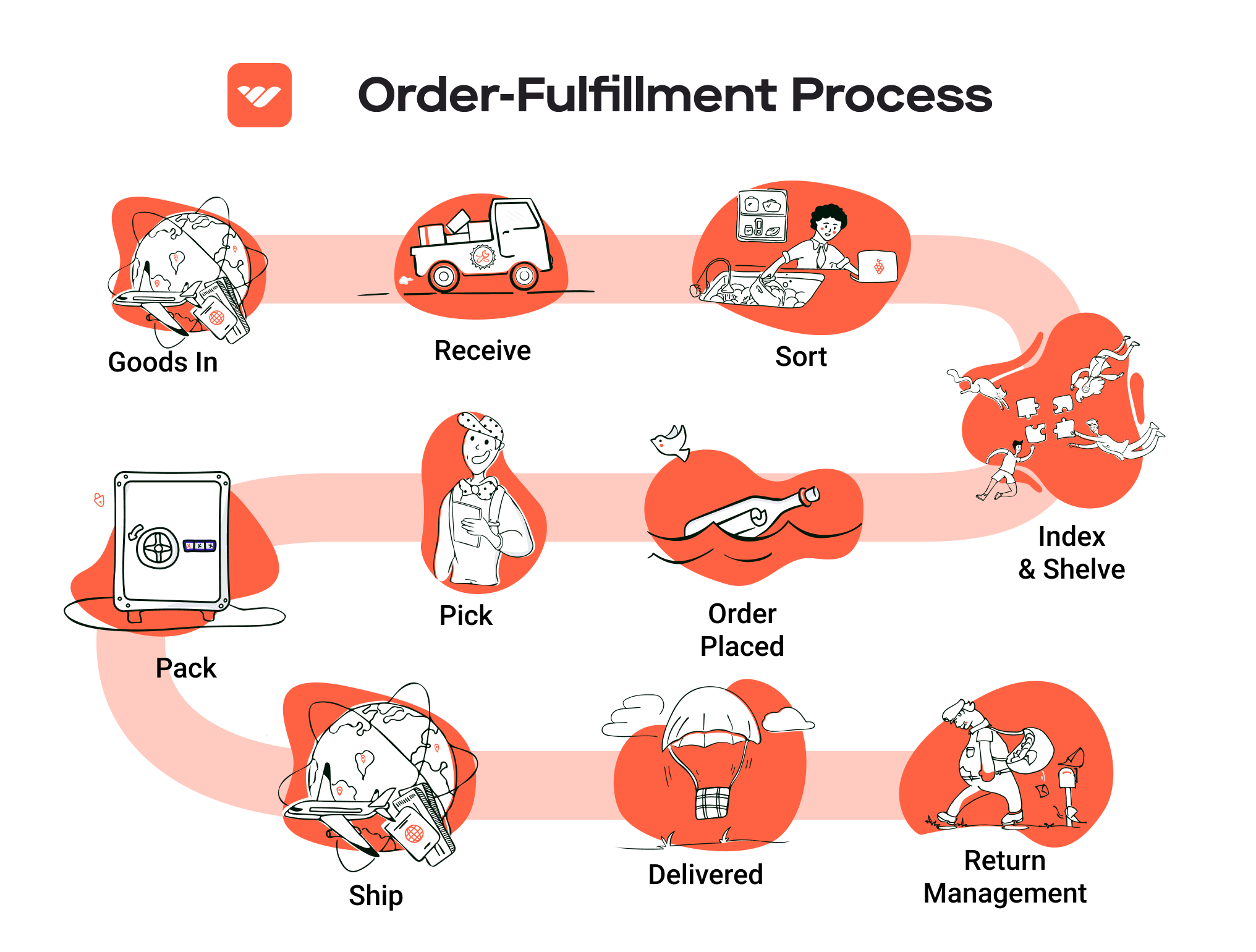
The importance of this step cannot be overstated; accurate picking is essential to ensuring customer satisfaction and reducing returns. There are various picking methods—such as batch picking (where multiple orders are picked simultaneously) or zone picking (where different pickers handle specific areas)—that can enhance efficiency based on the size and layout of the warehouse. Implementing technology like handheld scanners can improve accuracy and speed, reducing human error and the associated costs.
4. Order Packing
After items are picked, they move to the order packing stage, where products are carefully packaged for shipment. This step includes selecting appropriate packaging materials, adding invoices or packing slips, and ensuring that items are secure to prevent damage during transit. Packing stations are often equipped with tools like tape dispensers and scales to streamline this process.
Effective packing is vital for minimizing returns due to damage and ensuring that products arrive in pristine condition. Moreover, thoughtful packing can enhance the customer experience; branded packaging or personalized notes can leave a lasting impression. Businesses should also consider implementing kitting—combining multiple items into a single package—when fulfilling specific orders, which can further improve efficiency and customer satisfaction.
5. Shipping & Delivery
The final step in the order fulfillment process is shipping and delivery, where packaged orders are handed off to shipping carriers for distribution to customers. This stage requires coordination with various carriers, and the choice of shipping method can impact delivery speed and cost. Businesses often use a shipping management system to automate label printing and track shipments, ensuring customers receive timely updates.
This step is critical as it directly influences the customer’s perception of the business. Timely and accurate delivery can enhance customer loyalty, while delays or issues can lead to dissatisfaction and lost sales. Developing relationships with reliable shipping partners and offering multiple shipping options can further enhance service levels. Additionally, managing returns efficiently is essential; an effective returns management process can turn a potentially negative experience into a positive one, encouraging repeat purchases.
By understanding and optimizing each of these five steps in the order fulfillment process, e-commerce businesses can significantly enhance their operational efficiency, improve customer satisfaction, and ultimately scale their logistics operations successfully.
Comparing Fulfillment Models: In-House vs. 3PL vs. Dropshipping
Fulfillment Model Comparison Table
| Model | Who Handles Inventory | Best For (Business Stage) | Key Advantage | Key Disadvantage |
|---|---|---|---|---|
| In-House Fulfillment | The business itself | Established businesses | Full control over inventory and processes | High overhead costs and resource allocation |
| Third-Party Logistics (3PL) | A third-party provider | Growing businesses | Scalability and access to expertise | Less control over the fulfillment process |
| Dropshipping | Supplier or manufacturer | Startups and small businesses | Low upfront investment and no inventory holding | Lower profit margins and reliance on suppliers |
In-House Fulfillment
In-house fulfillment means that an e-commerce business manages all aspects of its warehousing and logistics internally. This model is typically adopted by established businesses that have sufficient resources and a customer base that justifies the investment in inventory management, staffing, and warehousing facilities. The primary advantage of in-house fulfillment is the complete control it provides over inventory levels, order processing, and customer service. Businesses can tailor their fulfillment processes to meet specific needs, implement quality control measures, and enhance the customer experience. However, this model also comes with significant disadvantages, including high overhead costs related to warehousing space, equipment, and labor. Additionally, businesses must invest in inventory management systems and technology to streamline operations, which can be a substantial burden for smaller operations or those just starting out.
Third-Party Logistics (3PL)
Third-party logistics (3PL) involves outsourcing fulfillment operations to a specialized provider that manages warehousing, inventory, and shipping. This model is ideal for growing businesses that need to scale quickly without the overhead of managing their logistics. By partnering with a 3PL, e-commerce companies can leverage the provider’s expertise, technology, and established processes to enhance their fulfillment capabilities. The key advantage of using a 3PL is scalability; as order volumes increase, the logistics provider can adapt to meet demand without requiring the business to make significant investments in infrastructure. However, one major drawback is the reduced control over the fulfillment process. Businesses must rely on the 3PL to maintain quality and efficiency, which can lead to challenges if the provider fails to meet expectations. Additionally, communication issues can arise, particularly if the 3PL operates on different systems or has varying standards.
Dropshipping
Dropshipping is a fulfillment model where the retailer does not hold inventory but instead partners with suppliers who ship products directly to customers. This model is particularly appealing to startups and small businesses due to its low upfront investment and minimal risk. Since the retailer does not need to purchase inventory upfront, it can offer a wide range of products without the burden of holding stock. This flexibility allows businesses to test new products and markets quickly. However, dropshipping also comes with significant challenges. The most notable disadvantage is the typically lower profit margins, as suppliers often charge higher prices for their products to compensate for the additional handling. Furthermore, businesses relying on dropshipping are at the mercy of their suppliers for inventory levels and shipping times, which can lead to customer dissatisfaction if products are out of stock or delayed. This reliance can complicate inventory management and fulfillment processes, making it crucial for retailers to establish strong relationships with reliable suppliers.
By understanding the nuances of each fulfillment model, e-commerce business owners can make informed decisions that align with their operational capabilities, growth ambitions, and customer service goals. Each model has its strengths and weaknesses, and the choice ultimately depends on the specific needs and stage of the business.
A Deep Dive into Amazon FBA: Pros, Cons, and Who It’s For
What is Fulfillment by Amazon (FBA)?
Fulfillment by Amazon (FBA) is a service provided by Amazon that allows sellers to store their products in Amazon’s fulfillment centers. Amazon takes care of the storage, packaging, and shipping of these products directly to customers. This service is designed to streamline the logistics of e-commerce for sellers, allowing them to focus on other aspects of their business while leveraging Amazon’s vast distribution network.
When a customer places an order for a product fulfilled by FBA, Amazon handles the entire process—from picking and packing the item to shipping it and providing customer service. Sellers benefit from Amazon’s sophisticated logistics capabilities, extensive reach, and established customer trust.
How FBA Works
-
Setup: Sellers create an Amazon Seller account and set up FBA by selecting the products they want to fulfill through Amazon. They prepare their items according to Amazon’s packaging guidelines and ship them to Amazon’s fulfillment centers.
-
Storage: Once the items arrive at the fulfillment center, they are stored until sold. Amazon’s system tracks the inventory levels in real-time, making it easier for sellers to manage their stock.
-
Order Processing: When a customer orders a product, Amazon’s sophisticated algorithms determine the nearest fulfillment center with the item in stock. The order is then picked from the shelves, packed, and shipped.
-
Customer Service: Amazon manages all customer service inquiries and returns for FBA orders, allowing sellers to focus on growing their business.
-
Payment: After an item sells, Amazon deducts the applicable fees from the seller’s account and deposits the remaining funds into the seller’s bank account.
Pros of FBA
1. Prime Eligibility
One of the most significant advantages of using FBA is that products become eligible for Amazon Prime, which offers customers free two-day shipping. This can significantly increase sales, as Prime members tend to prefer products that offer fast shipping options.
2. Customer Trust
Amazon is synonymous with reliability and quality service. By using FBA, sellers benefit from the trust customers have in Amazon. This trust can lead to higher conversion rates, as customers are more likely to purchase from a seller that offers FBA.
3. Multi-Channel Fulfillment
FBA isn’t limited to just Amazon.com. Sellers can also use FBA to fulfill orders from other sales channels, such as their own e-commerce sites or other marketplaces. This flexibility allows for a unified logistics strategy across different platforms.
4. Streamlined Operations
FBA simplifies the logistics process. Sellers don’t need to worry about managing their own warehouse, hiring staff for packing and shipping, or dealing with customer service, which can be time-consuming and costly.
5. Access to Advanced Tools
Sellers using FBA gain access to Amazon’s extensive suite of tools and analytics, which can help optimize inventory management, track sales performance, and enhance marketing efforts.
Cons of FBA
1. High Fees
While FBA can save time and resources, it comes at a cost. Amazon charges various fees, including storage fees for items held in their warehouses and fulfillment fees for each order processed. These costs can quickly add up, especially for sellers with low margins or slow-moving products.
2. Strict Inventory Rules
Sellers must adhere to Amazon’s strict inventory management policies. This includes guidelines on product preparation, packaging, and labeling. Non-compliance can result in additional fees or even the removal of inventory from the fulfillment center.
3. Commingling Risks
FBA products may be commingled, meaning that a seller’s inventory can be stored alongside that of other sellers. This poses a risk if a customer receives a defective or counterfeit item. In such cases, the original seller may face challenges in addressing customer complaints and may be held accountable for the return, impacting their reputation.
4. Limited Control Over Shipping
While Amazon handles the logistics, sellers have limited control over shipping times and methods. This can be problematic during peak seasons or in cases of fulfillment delays, as it could impact customer satisfaction and seller ratings.
5. Inventory Management Challenges
With FBA, sellers need to be proactive in managing their inventory levels. Overestimating demand can lead to high storage fees, while underestimating can result in stockouts and lost sales.
Who is FBA Best For?
FBA is particularly well-suited for:
- Small to Medium-Sized Businesses: Sellers who lack the resources to manage their own logistics can benefit from FBA’s comprehensive services.
- Brands with High Sales Volume: Those who anticipate a high volume of sales can take advantage of the efficiencies FBA provides, especially during peak shopping seasons.
- Sellers Focused on Growth: Businesses looking to scale quickly can leverage Amazon’s vast customer base and fulfillment capabilities without the need for significant upfront investment in logistics.
- Multi-Channel Sellers: Brands that sell across multiple platforms will find FBA’s multi-channel fulfillment capabilities advantageous for streamlining their operations.
In conclusion, while FBA offers numerous advantages, including increased visibility and customer trust, potential users must weigh these benefits against the associated costs and risks. Understanding the operational requirements and financial implications of FBA is crucial for making an informed decision that aligns with a seller’s overall business strategy.
Core Services Offered by Fulfillment Centers
Inventory Management & Warehousing
Inventory management is a foundational service provided by fulfillment centers, enabling e-commerce businesses to efficiently track and control their stock levels. This service encompasses the organization, storage, and oversight of products in a warehouse environment. Fulfillment centers utilize advanced Warehouse Management Systems (WMS) to monitor real-time inventory data, ensuring accurate stock counts and optimal inventory levels.
Benefits:
1. Avoiding Stockouts and Overstocks: Effective inventory management minimizes the risk of stockouts, which can lead to lost sales and dissatisfied customers. It also helps prevent overstocks that can increase holding costs.
2. Improved Forecasting: With accurate inventory data, businesses can make informed decisions about future orders, enhancing their ability to forecast demand and adjust inventory levels accordingly.
3. Operational Efficiency: A well-organized warehouse allows for faster order processing, reducing the time it takes to pick and ship products. This efficiency can lead to improved customer satisfaction through quicker delivery times.
Pick and Pack Services
Pick and pack services are critical to the fulfillment process, where items are selected from inventory based on customer orders and prepared for shipment. This process involves several steps, including locating the products, picking them from the shelves, packing them into shipping containers, and labeling them for delivery.
Benefits:
1. Labor Efficiency: Fulfillment centers utilize various picking methods—such as batch picking, zone picking, and wave picking—to streamline operations and reduce labor costs. This ensures that orders are processed quickly and accurately.
2. Scalability: As e-commerce businesses grow, fulfillment centers can scale their pick and pack operations to handle increased order volumes without sacrificing speed or accuracy.
3. Customization: Many fulfillment centers offer customizable packing options, allowing businesses to enhance their brand presence through tailored packaging solutions, which can improve customer experience and loyalty.
Kitting and Assembly
Kitting and assembly are value-added services that involve grouping multiple products into a single package or assembling components into a finished product. This can include bundling items for promotional offers or assembling products requiring multiple parts before shipping.
Benefits:
1. Enhanced Customer Experience: By offering kitted products, e-commerce businesses can provide customers with a more convenient shopping experience, as they receive all necessary items in one package.
2. Streamlined Operations: Kitting can reduce the complexity of order fulfillment by consolidating multiple items into a single SKU, simplifying inventory management and order processing.
3. Customization Opportunities: Businesses can create unique product offerings through kitting, allowing for promotional bundles or seasonal packages that can attract more customers and increase sales.
Returns Management (Reverse Logistics)
Returns management, or reverse logistics, is an essential service that addresses the return of products from customers back to the fulfillment center. Effective returns management ensures that returned items are processed efficiently, whether they are restocked, refurbished, or disposed of.
Benefits:
1. Customer Retention: A seamless return process enhances customer satisfaction and can lead to repeat purchases. Customers are more likely to shop with a brand that offers hassle-free returns.
2. Inventory Recovery: Efficient returns management allows businesses to quickly assess returned products and determine their condition, enabling timely restocking of sellable items and minimizing losses.
3. Data Insights: Analyzing return data can provide valuable insights into customer preferences and product quality issues, allowing businesses to improve product offerings and reduce future returns.
By leveraging these core services, e-commerce businesses can enhance their operational efficiency, improve customer satisfaction, and ultimately drive growth in a competitive marketplace.
How to Choose a Fulfillment Partner: A 6-Point Checklist
Location & Warehouse Network
Importance:
The geographical location of your fulfillment partner is crucial for reducing shipping times and costs. A strategically located warehouse network can enhance your service delivery, especially if you have a broad customer base across different regions.
Questions to Ask:
– Where are your warehouses located, and how do they align with my customer demographics?
– What is your average shipping time to key regions?
– Do you have a multi-warehouse strategy to optimize shipping costs and delivery times?
– How do you handle shipping to remote or international locations?
Technology & Integrations
Importance:
In today’s digital age, the technology a fulfillment partner employs can greatly affect operational efficiency. A robust Warehouse Management System (WMS) can streamline processes, reduce errors, and provide real-time inventory visibility.
Questions to Ask:
– What technology platforms do you use for inventory management, order processing, and shipping?
– How do you integrate with existing e-commerce platforms and other tools in my tech stack?
– Can your system provide real-time updates and tracking for both my team and customers?
– What measures are in place to ensure data security and compliance?
Specializations (e.g., cold storage, oversized items)
Importance:
Not all fulfillment centers are equipped to handle every type of product. If your business involves specialized items, such as perishables or oversized products, you need a partner with the appropriate capabilities.
Questions to Ask:
– What types of products do you specialize in fulfilling?
– Do you have specific facilities for temperature-sensitive items?
– How do you manage the handling of oversized or fragile items?
– Can you accommodate custom packaging or kitting for my products?
Scalability & Capacity
Importance:
As your business grows, your fulfillment needs will evolve. It’s essential to partner with a fulfillment provider that can scale with your business, whether you’re experiencing seasonal spikes in demand or expanding your product range.
Questions to Ask:
– What is your current capacity, and how do you plan to manage increased order volumes?
– Can you provide examples of how you’ve scaled operations for other clients?
– What systems do you have in place to manage inventory overflow or peak seasons?
– How quickly can you adapt to changes in order volume or product lines?
Pricing and Contracts
Importance:
Understanding the pricing structure and contract terms of a fulfillment partner is vital to ensure profitability and avoid unexpected costs. Transparent pricing helps you forecast expenses accurately.
Questions to Ask:
– What is your pricing model (e.g., per order, per item, storage fees)?
– Are there any hidden fees, such as for returns or special handling?
– How flexible are your contract terms? Is there an option for short-term agreements?
– Can you provide a detailed breakdown of costs associated with your services?
Customer Support & Reviews
Importance:
Effective customer support can be a game-changer during critical times, such as peak seasons or when resolving issues. A partner with strong customer service will help ensure smooth operations and maintain customer satisfaction.
Questions to Ask:
– What does your customer support structure look like (e.g., dedicated account managers, 24/7 support)?
– How quickly do you typically respond to inquiries or issues?
– Can you provide testimonials or case studies from current or past clients?
– What processes do you have in place for handling errors or issues in order fulfillment?
Conclusion
Choosing the right fulfillment partner is a pivotal decision that can significantly impact your e-commerce business’s efficiency and customer satisfaction. By using this checklist, you can ensure that you select a partner whose capabilities align with your operational needs and growth ambitions. Remember to conduct thorough due diligence and ask the right questions to make an informed choice that supports your business’s long-term success.
Understanding Fulfillment Pricing: A Breakdown of Common Fees
Initial Setup Fees
Initial setup fees are one-time charges associated with onboarding your business to a fulfillment center. These fees can cover a variety of services, including the configuration of your inventory in the warehouse management system (WMS), integration with your e-commerce platform, and any necessary customization of the fulfillment process to meet your specific requirements.
Typically, initial setup fees can range from a few hundred to several thousand dollars, depending on the complexity of your needs. For example, if your business requires specialized handling or kitting services, expect the setup fee to be on the higher end. To get a precise estimate, it’s crucial to discuss your business model, product types, and expected order volume with potential fulfillment partners.
Receiving Fees
Receiving fees are charged for the process of unloading goods from trucks, inspecting them for damage, and entering them into the warehouse inventory system. These fees are generally calculated based on the volume of goods received and can include charges per pallet or per hour spent by staff on receiving activities.
For instance, if your shipment consists of multiple pallets, a fulfillment center may charge a flat fee per pallet received. It’s essential to clarify if the fee includes quality checks and inventory management tasks, as this can significantly impact your overall costs. Knowing the specifics of what is included in the receiving fee will help you budget effectively.
Storage Fees (per pallet/bin)
Storage fees apply to the space your products occupy within the warehouse. These fees are typically calculated on a per pallet or per bin basis and can vary depending on the type of products stored. For example, perishable goods may incur higher storage fees due to the need for specialized conditions, while non-perishable items may have lower rates.
Storage fees can be charged monthly, quarterly, or annually, and they are often influenced by the overall inventory turnover rate. If you have a high turnover rate, you may negotiate for lower storage fees, while products with slower sales may incur higher costs. Understanding how your inventory moves will help you manage these fees more effectively.
Pick & Pack Fees (per item/order)
Pick and pack fees are among the most significant costs in fulfillment. This fee is charged for the labor involved in retrieving items from storage and preparing them for shipment. Typically, fulfillment centers charge on a per item or per order basis.
For example, if your order consists of multiple items, the fulfillment center may charge a fee for each item picked, plus a flat fee for packing the order. Some facilities offer tiered pricing based on order volume, where higher volumes lead to lower per-item fees. It’s important to analyze your average order size and frequency to estimate your pick and pack costs accurately.
Shipping Fees
Shipping fees are the costs associated with transporting your products to customers. These fees can vary widely based on several factors, including the shipping method (ground, air, etc.), destination, package weight, and dimensions.
Fulfillment centers often have relationships with various carriers and can offer competitive shipping rates based on your shipping volume. Additionally, they may provide options for expedited shipping, which will incur higher fees. Understanding the shipping fee structure and discussing your shipping needs upfront can help you find the most cost-effective solutions for your business.
Tips for Getting an Accurate Quote
-
Provide Detailed Information: When requesting quotes from fulfillment centers, be specific about your product types, average order sizes, and expected order volume. This information will help them provide a more accurate estimate.
-
Ask About All Fees: Ensure that you inquire about all potential fees, including hidden or additional costs that may not be immediately apparent, such as returns management or special handling fees.
-
Negotiate Terms: Don’t hesitate to negotiate terms and fees. Many fulfillment centers are open to discussions, especially if you can guarantee higher volumes or longer contract terms.
-
Consider Seasonal Variability: If your business has seasonal peaks, discuss how this will affect pricing and whether there are options for scaling fees during high-demand periods.
-
Compare Multiple Quotes: Finally, compare quotes from multiple fulfillment centers to get a well-rounded view of the market. This will not only help you identify the best price but also the best service level for your needs.
By understanding these common fulfillment pricing models, you can make informed decisions that align with your business goals, ultimately enhancing your logistics strategy as you scale.
Frequently Asked Questions (FAQs) about Fulfillment
1. What is the difference between a warehouse and a fulfillment center?
A warehouse primarily serves as a storage space for goods, often for extended periods. In contrast, a fulfillment center is more dynamic, focusing on the quick processing and shipping of orders. Fulfillment centers handle picking, packing, and shipping directly to customers, making them essential for e-commerce operations.
2. What is a 3PL?
A 3PL, or third-party logistics provider, is a service that manages logistics for businesses, including warehousing, order fulfillment, and shipping. By outsourcing these operations to a 3PL, e-commerce businesses can streamline their supply chain, reduce overhead costs, and focus on core competencies like marketing and product development.
3. How much do fulfillment services cost?
The cost of fulfillment services varies based on factors such as order volume, storage space required, and specific services needed (like kitting or returns management). Typically, fulfillment providers charge fees based on storage (per cubic foot), order processing (per order or per item), and shipping (carrier rates). Businesses should request quotes from multiple providers to find the best fit for their needs.
4. How does inventory management work in a fulfillment center?
Inventory management in a fulfillment center involves tracking and organizing stock levels to ensure that products are available for order fulfillment without overstocking. This includes using advanced warehouse management systems (WMS) to monitor real-time inventory data, forecast demand, and maintain optimal stock levels to prevent stockouts or excess inventory.
5. What are the benefits of using a fulfillment center?
Using a fulfillment center can provide numerous benefits, including faster order processing times, reduced operational costs, access to advanced logistics technology, and improved scalability. This allows businesses to focus on growth while ensuring efficient handling of their logistics and fulfillment processes.
6. How do I choose the right fulfillment partner?
When selecting a fulfillment partner, consider factors such as their location, technology capabilities (like WMS), range of services offered (like returns management and kitting), reputation in the industry, and pricing structure. It’s also beneficial to look for a partner who understands your specific business needs and can provide customized solutions.
7. What is kitting and assembly in the context of fulfillment?
Kitting is the process of bundling multiple items together into one package for shipment, while assembly involves putting together components to create a finished product. Both processes are important in fulfillment to ensure that customers receive complete and accurate orders, enhancing the overall customer experience.
8. How do fulfillment centers handle returns?
Fulfillment centers manage returns through a structured returns management process (RMA). This includes receiving returned items, inspecting them, restocking sellable products, and processing refunds or exchanges. An efficient returns process is crucial for maintaining customer satisfaction and minimizing losses.
9. What technologies improve fulfillment operations?
Technologies that enhance fulfillment operations include warehouse management systems (WMS), automated picking systems, conveyor belts, and robotics. These technologies help streamline processes, reduce human error, and improve overall efficiency in order fulfillment.
10. How can I scale my fulfillment operations as my business grows?
To scale fulfillment operations, start by optimizing your inventory management and fulfillment processes, investing in technology that integrates various logistics functions, and exploring partnerships with 3PL providers. Additionally, consider diversifying your warehouse locations to reduce shipping times and costs as your customer base expands.
Conclusion: Is Outsourcing Fulfillment the Right Move for Your Business?
Evaluating the Benefits of Outsourcing Fulfillment
Outsourcing fulfillment can be a game-changer for e-commerce businesses looking to scale efficiently. One of the primary advantages is time savings. By leveraging a fulfillment service, businesses can free up valuable hours spent on inventory management, order processing, and shipping logistics. This allows entrepreneurs and operations managers to focus on core business activities such as marketing, product development, and customer engagement, which are crucial for growth.
Scalability is another significant benefit. As your business grows, so do your fulfillment needs. A reliable fulfillment partner can easily accommodate fluctuations in order volume, seasonal spikes, and even unexpected surges in demand. This flexibility ensures that you can meet customer expectations without the need for substantial upfront investments in warehousing and staffing.
Moreover, fulfillment centers bring specialized expertise to the table. With advanced warehouse management systems and experienced staff, these partners can optimize inventory management, streamline picking and packing processes, and improve shipping accuracy. Their knowledge of logistics can also help you navigate challenges such as returns management and international shipping, further enhancing your operational efficiency.
However, the success of outsourcing fulfillment hinges on choosing the right partner. It’s essential to evaluate potential partners based on their technology, reliability, and service offerings to ensure alignment with your business goals.
Call to Action
To determine if outsourcing fulfillment is the right move for your business, conduct a thorough audit of your current shipping process. Analyze your order fulfillment times, costs, and customer satisfaction levels. This assessment will provide valuable insights into whether a fulfillment partner could enhance your operational efficiency and support your growth objectives. Take the next step towards scaling your business effectively by exploring the options available in the fulfillment landscape today.
Important Disclaimer
⚠️ Important Disclaimer
The information in this guide is for educational purposes. Fulfillment services, pricing, and platform features change frequently. Always conduct your own due diligence and consult with providers directly before making business decisions.
